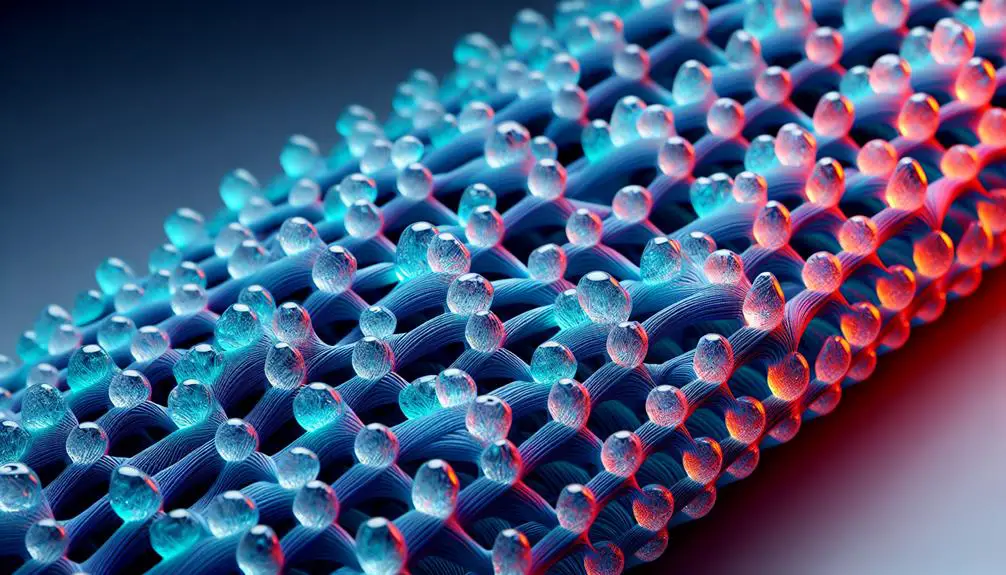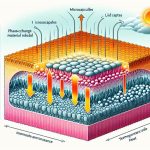Imagine you're hiking on a trail, and suddenly the weather shifts from chilly to warm within minutes. Just like that, phase-change materials (PCMs) in smart fabrics respond to temperature changes, absorbing excess heat and keeping you comfortable. These advanced materials act like a thermal sponge, storing and releasing heat to maintain a stable temperature. But how exactly do they work, and what makes them so effective in smart clothing? Understanding the science behind PCMs could revolutionize how you perceive comfort in your daily wear.
Table of Contents
Key Takeaways
- Phase-change materials (PCMs) in fabrics regulate body temperature by absorbing and releasing heat.
- PCMs enhance thermal comfort with high latent heat capacity, shifting between solid and liquid states.
- Smart fabrics with PCMs store thermal energy, contributing to energy efficiency and sustainability.
- Integration of PCMs in textiles allows for breathability and flexibility, ideal for athletic and medical applications.
- PCMs in smart fabrics offer precise temperature control, reducing energy consumption and carbon footprint.
Understanding Phase-Change Materials
Phase-change materials (PCMs) in smart fabrics manage temperature by absorbing and releasing heat. To understand how these materials work, focus on their unique properties. PCMs shift between solid and liquid states within a specific temperature range. This phase alteration is what allows them to absorb excess heat when temperatures rise and release stored heat when temperatures drop.
By integrating PCMs into textiles, you're creating fabrics that can maintain ideal temperature conditions. The material properties of PCMs are critical; they need to have a high latent heat capacity, meaning they can absorb and release significant amounts of heat without undergoing a significant change in temperature themselves. This characteristic is key to their effectiveness in regulating thermal comfort.
Energy efficiency is another major benefit. When incorporated into clothing, PCMs help reduce the need for additional heating or cooling, making them not only practical but also environmentally friendly.
You're effectively creating garments that adjust to external temperatures, reducing the energy required to keep you comfortable. This translates to fewer resources spent on artificial climate control, making your wardrobe smarter and more sustainable.
Understanding these material properties and their impact on energy efficiency sets the foundation for mastering the use of PCMs in smart fabrics.
How PCMs Work
When you wear fabrics with PCMs, they store thermal energy by absorbing excess heat from your body. This heat absorption process helps regulate your body temperature, keeping you comfortable.
As temperatures drop, the stored heat is slowly released back to you.
Thermal Energy Storage
PCMs, or phase-change materials, absorb and release thermal energy to help regulate temperature in smart fabrics. They play a vital role in enhancing energy efficiency and driving textile innovation. When integrated into textiles, PCMs can store excess heat and release it when temperatures drop, maintaining thermal comfort and aligning with sustainability trends.
To understand how PCMs work, consider these important aspects:
- Heat Absorption and Release: PCMs change their physical state based on temperature fluctuations, absorbing heat when it's too warm and releasing it when it cools down.
- Material Integration: These materials can be embedded into fibers or coatings, ensuring the fabric remains flexible and breathable while providing thermal regulation.
- Energy Efficiency: By reducing the need for external heating or cooling, fabrics with PCMs contribute to significant energy savings, which is vital for both economic and environmental sustainability.
Heat Absorption Process
To grasp the heat absorption process, envision the materials inside your smart fabric capturing excess warmth as the temperature rises. Phase-change materials (PCMs) embedded in the fabric undergo a transformation from solid to liquid, a state change that absorbs significant amounts of heat. This process is pivotal for effective heat transfer, as it prevents your body from overheating by storing thermal energy within the fabric itself.
When temperatures increase, PCMs inside the textile absorb the heat, maintaining a stable temperature for the wearer. This thermal regulation is a hallmark of textile innovation, ensuring both comfort and energy efficiency. By managing the heat transfer process efficiently, smart fabrics reduce the need for external cooling mechanisms.
As the environment cools, the PCMs revert to their solid state, releasing the stored heat back to your body. This cyclical process enhances the fabric's ability to adapt to varying temperatures, providing consistent comfort.
Mastering the science behind this heat absorption process allows you to appreciate the sophistication of smart fabrics. It's not just about staying warm or cool; it's about optimizing energy use and achieving superior thermal regulation through advanced textile technology.
Types of PCMs
Now, let's look at the different types of PCMs you'll encounter in smart fabrics.
You'll find organic PCM varieties, inorganic PCM options, and eutectic PCM blends, each with unique properties.
Understanding these types will help you choose the best one for your needs.
Organic PCM Varieties
Organic phase change materials (PCMs) come in several varieties, each with unique properties and applications. If you're seeking natural options and sustainable solutions, organic PCMs are your best bet. These materials are derived from natural sources and offer several benefits for smart fabrics.
- Paraffins: These are hydrocarbon compounds that melt and solidify at specific temperatures, providing effective thermal regulation. Paraffins are popular due to their high latent heat and repeatable phase-change processes.
- Fatty Acids: These organic compounds come from animal fats and vegetable oils. Fatty acids are biodegradable, making them an environmentally friendly choice. They offer consistent performance, are cost-effective, and are easy to integrate into textiles.
- Bio-based PCMs: These are derived from renewable biological sources, such as plants. Bio-based PCMs support sustainability goals and reduce reliance on fossil fuels. They're particularly suitable for applications where environmental impact is a key concern.
Inorganic PCM Options
Inorganic phase shift materials (PCMs) offer resilient thermal management solutions, often outperforming their organic counterparts when it comes to thermal conductivity and stability. If you're looking to enhance your smart fabric's thermal regulation capabilities, inorganic PCMs are a formidable option to contemplate.
Silicone based PCMs are a popular choice due to their exceptional durability and flexibility. These materials not only withstand a wide range of temperatures but also maintain their phase shift properties over numerous cycles. Silicone's innate flexibility makes it an ideal candidate for integration into various fabric types without compromising comfort or wearability.
Salt hydrate formulations, another crucial category of inorganic PCMs, bring their own set of advantages to the table. They offer high latent heat storage capacity and are generally more cost-effective than other PCM types. Salt hydrates are particularly effective in applications requiring precise thermal control, as they exhibit sharp phase shift temperatures. However, they can be prone to phase separation and supercooling, which necessitates careful formulation and stabilization.
Eutectic PCM Blends
For those seeking versatile thermal management solutions, eutectic PCM blends offer a unique combination of properties that can enhance the performance of smart fabrics. These blends consist of two or more phase-change materials (PCMs) that, when combined, create a mixture with a lower melting point than the individual components. This characteristic provides several benefits, making them ideal for applications requiring precise thermal regulation.
Eutectic blends are particularly advantageous due to:
- Optimized thermal conductivity: By combining different materials, you can achieve a balance of thermal conductivity that maximizes energy efficiency.
- Tailored melting points: Eutectic blends allow for customization of melting points, enabling you to design fabrics that respond to specific temperature ranges.
- Enhanced energy efficiency: These blends improve the energy efficiency of smart fabrics by optimizing the amount of thermal energy absorbed and released.
Incorporating eutectic PCM blends in smart fabrics means you can create garments that adapt to changing temperatures more effectively. This adaptability can greatly enhance comfort and performance, making these materials an excellent choice for high-tech clothing applications. By leveraging the unique properties of eutectic blends, you're setting a new standard for innovation in thermal management.
Integration Into Fabrics
To seamlessly blend technology with textiles, manufacturers embed electronic components directly into the fabric's fibers. This fusion of fabric technology and innovative textiles results in smart clothing that's not just functional but also profoundly transformative. You'll find that wearable technology isn't just about gadgets anymore; it's about integrating advanced functionalities into everyday attire, turning passive materials into active participants in your comfort and well-being.
By weaving phase-change materials (PCMs) into the fibers, the fabric can intelligently respond to temperature changes, making your smart clothing adaptive and highly efficient. The process involves encapsulating PCMs in microcapsules, which are then integrated into the fabric. This guarantees that the textile remains soft and flexible, maintaining the comfort you expect from traditional clothing, while offering the advanced benefits of wearable technology.
Additionally, innovative textiles incorporate sensors and conductive threads, allowing for seamless data transmission. This enables real-time monitoring and interaction with other smart devices. You'll appreciate how these fabrics can be programmed to perform specific functions, like warming up during cold spells or cooling down when it's hot, without compromising style or comfort. With such integration, your clothing becomes an extension of your technological ecosystem.
Temperature Regulation
Smart fabrics' ability to regulate temperature is one of their most impressive features, ensuring you stay comfortable regardless of the weather. Leveraging advanced fabric technology, these smart textiles offer unparalleled thermoregulation by responding dynamically to your body's needs. Whether it's a sweltering summer day or a chilly winter evening, these fabrics adjust to maintain an ideal temperature.
Here's how they work:
- Heat Absorption: When it's hot, cooling fabrics absorb excess body heat, keeping you cool.
- Heat Release: In colder conditions, the materials release stored heat to keep you warm.
- Phase-Change Materials (PCMs): These specialized elements within the fabric undergo phase changes (from solid to liquid and vice versa) to manage temperature effectively.
By integrating PCMs into smart textiles, these fabrics can absorb, store, and release heat as needed. This makes them incredibly efficient at maintaining a stable internal temperature. The result? You get to enjoy a consistent level of comfort.
Understanding the intricacies of fabric technology and thermoregulation can elevate your appreciation for these innovative textiles. Mastering the use of smart fabrics means you'll always be prepared for whatever Mother Nature throws your way, without compromising on comfort or performance.
Benefits of PCMs
Among the numerous benefits of PCMs, their ability to provide precise temperature control stands out. You'll appreciate how these materials absorb and release heat to maintain an ideal temperature, ensuring you're neither too hot nor too cold. This temperature regulation translates directly into energy efficiency, as less energy is required to heat or cool the environment around you.
Comfort enhancement is another key advantage. With PCMs integrated into fabrics, you'll experience a consistent microclimate that adapts to your body's needs. This results in unparalleled comfort, whether you're navigating a scorching summer day or enduring a frigid winter night.
Sustainability benefits are also significant. By reducing the need for artificial heating and cooling, PCMs help lower your carbon footprint. This eco-friendly approach contributes to a more sustainable future, aligning perfectly with a growing commitment to environmental responsibility.
Cost effectiveness is an added bonus. Because PCMs reduce energy consumption, you'll see a decrease in your utility bills. Over time, the savings on energy costs can be substantial, making PCM-infused fabrics a wise investment for both your wallet and the planet.
Current Applications
You'll find intelligent textiles infused with PCMs in a variety of everyday items, from athletic wear to bedding. These materials are revolutionizing how you experience temperature regulation in your daily life. The market demand for these innovative textiles is skyrocketing, driven by their ability to adapt to your body's needs in real-time.
Consider the following applications:
- Athletic Wear: Brands are incorporating PCMs into sports apparel to help manage body heat, keeping you cooler during intense workouts and warmer during cool-down periods.
- Bedding: PCM-infused sheets and comforters ensure you enjoy a restful night's sleep by maintaining an ideal sleep temperature.
- Medical Textiles: These intelligent fabrics are used in bandages and garments to aid in temperature-sensitive treatments.
The advancements in PCM technology aren't just about comfort; they're also about sustainability. By improving the efficiency of temperature regulation, these materials reduce the need for heating and cooling systems, lowering energy consumption.
Innovations in this field are continually evolving, meeting both the demands for high-performance products and the growing emphasis on environmental responsibility.
In essence, PCMs in intelligent fabrics offer significant benefits that align with contemporary market demands and sustainability goals, making them an essential component of modern textile innovation.
Future Prospects
The future of intelligent textiles promises groundbreaking advancements that will further integrate technology into our everyday lives. As you look ahead, you'll see how market opportunities for smart fabrics are set to expand dramatically. High-performance athletic wear, medical monitoring garments, and even adaptive military uniforms are just the tip of the iceberg. These textiles aren't just about comfort—they'll help you achieve peak performance and health.
Technological advancements will drive this revolution. Imagine fabrics embedded with nanotechnology that can monitor essential signs in real time, or textiles that adjust their thermal properties based on your environment. These aren't futuristic fantasies; they're on the horizon.
Smart fabrics will also benefit from the integration of artificial intelligence, allowing for real-time data processing and adaptive responses to your body's needs.
You'll find that these innovations open up unparalleled market opportunities. Companies will be able to offer hyper-personalized products, and consumers like you'll enjoy unprecedented levels of customization and functionality.
Frequently Asked Questions
How Do Phase-Change Materials Impact the Environment?
Did you know that phase-change materials can reduce energy consumption by up to 30%? They offer significant environmental impact and sustainability benefits by regulating temperature efficiently, lowering reliance on heating and cooling systems.
Are There Any Potential Health Risks Associated With Pcms?
When considering the current question, you should address safety concerns and health implications. Potential health risks of PCMs include skin irritation or allergic reactions, but these are generally minimal with proper use and quality control.
What Is the Cost Comparison Between PCM Fabrics and Traditional Fabrics?
Think of PCM fabrics like high-end sports cars; they're pricier but deliver superior performance. In your cost analysis, you'll find PCM fabrics cost more upfront, yet they offer unparalleled comfort and efficiency compared to traditional fabrics.
How Long Do PCM Fabrics Typically Last Before Needing Replacement?
When considering fabric durability, PCM fabrics typically last 3-5 years before needing replacement. The replacement frequency depends on usage and care, so you'll want to follow maintenance guidelines to maximize their lifespan and performance.
Can Phase-Change Materials Be Recycled or Reused?
You can definitely look into the recycling and reusability of these materials. Many phase-change materials are designed to be environmentally friendly, allowing them to be recycled or even reused in other applications, enhancing their sustainability.
- How Does Ring Spun Cotton Affect Garment Fit and Shape Retention? - August 13, 2024
- What Are the Challenges in Producing Ring Spun Cotton? - August 13, 2024
- Is Ring Spun Cotton Suitable for Plus-Size Clothing? - August 13, 2024







